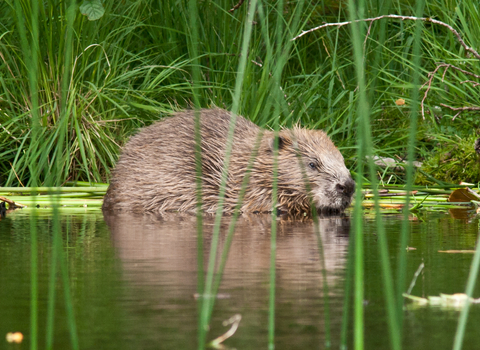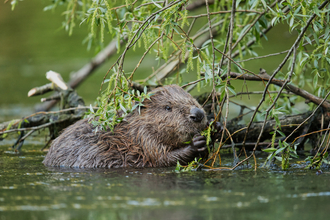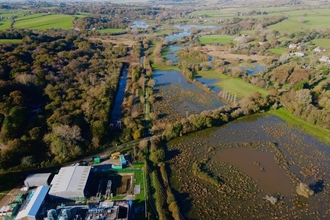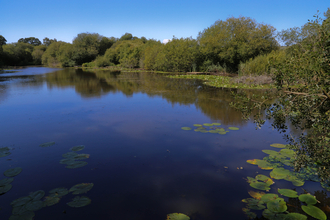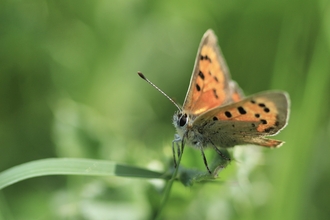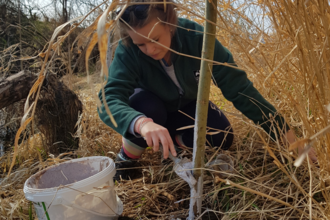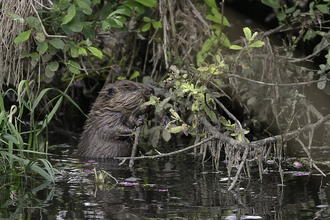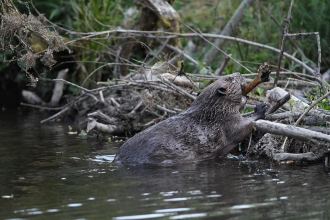The Isle of Wight Beaver Recovery Project
The Isle of Wight Beaver Recovery Project is a part of the Hampshire & Isle of Wight Wildlife Trust's Wilder Wight vision, which aims to restore and protect the island's natural heritage in the face of the climate and ecological emergency.
Our aspiration is to establish a long-term, free-living population of beavers on the Isle of Wight through a carefully planned release strategy. This project has the potential to support transformative change and contribute to the restoration of a thriving ecosystem on the island. Join us in our efforts to bring back this charismatic species and create a brighter future for the Isle of Wight's wildlife and natural landscapes.
Images from existing beaver projects
Click on the information button on each image to find out more.
Project so far
For information on the progress of the project view our yearly updates below.
2020
In 2020 the Trust commissioned a report and field survey by Dr Róisín Campbell-Palmer, Derek Gow, Prof Richard Brazier and Dr Alan Puttock. The study assessed the habitat suitability for beaver on the Isle of Wight and provided a feasibility for release scenarios. Particular emphasis was given to the Eastern Yar catchment, where a large proportion of Trust land occupies the river corridor, such as at Newchurch Moors Nature Reserve.
The report determined:
That some riparian environments on the Isle of Wight afford entirely suitable beaver habitat while in tandem others would provide for successful long-term colonisation.
The high degree of suitability would allow beavers from an unfenced release or series of releases on Trust reserves to colonise and establish the lower catchment, with permitted natural spread over time spreading the benefits of enhanced biodiversity and ecosystem service provision. This scenario could be successfully implemented in conjunction with well adopted beaver management strategies.
Existing collaborative partnership conservation and land-management projects on the Island already recognise and promote objectives such as managing scrub woodland, habitat connectivity, promotion of sustainable tourism, developing high value green spaces, woodland replanting and flood prevention. These activities all readily lend themselves to beaver reintroduction.
The Trust has secured funding to take the project to the next phase of feasibility, consultation and engagement:
This would shape a potential license application to Natural England to release beavers within the framework of a specified release strategy.
Hampshire & Isle of Wight Wildlife Trust have also been contributing to a national Wildlife Trust working group, representative of many Wildlife Trusts, with both existing and pending beaver projects. Part of the purpose of this group is to:
- Inform national-level engagement with government to clarify the legal status of beaver.
- To adopt a national beaver management framework.
- To explore ways of incentivising beaver presence and management within the new Environmental Land Management Scheme (ELMS).
The Beaver Trust has also been a close consultee of the Trust’s emerging plans and we are grateful for the support and advice provided to date.
2021
Beaver recovery project officer for the Isle of Wight appointed.
In the Summer of 2021 a beaver recovery project officer for the Isle of Wight was appointed. Her first steps will be engaging the Island community and stakeholders about beavers and how important they are for restoring healthy wetland ecosystems. As part of this she will also be seeking local opinions to help inform our license application to reintroduce beavers to the Isle of Wight.
2022
Consultation launched
The Trust mailed a questionnaire to every home on the island in February 2022 asking residents for their views on a potential release of the aquatic mammals in the Eastern Yar valley.
Consultation Results
A total of 4,883 people responded to the consultation with 89% stating they feel positively about beavers being released on the Isle of Wight. Beaver Consultation Survey results.
2023
The Beaver Project Steering Group visit sites in Devon and Cornwall to see places with free-living beavers and talk to local landowners. A draft beaver management strategy and ecological assessment are completed as part of the licence application.
2024
In the absence of a national beaver strategy the wild release of beavers has been stalled. Work continues on the licence application and further consultation with East Yar communities is planned.
FAQs
Are beavers native?
Beavers are a native species to Britain and were lost from our wetlands a few hundred years ago. They were hunted to extinction for their fur, meat and castoreum. Many places derive their names from the presence or influence of beaver activity on the local areas. We have perhaps lost the recent cultural memory and association from living among these animals but many river catchments today still exhibit signs of beaver activity from hundreds of years prior.
In Hampshire fossil evidence has been discovered on the Test & Itchen catchments ranging from Bronze Age to Medieval eras. Evidence is limited for the Isle of Wight but this should not be deemed as evidence of absence. The locality of the island to the mainland coupled with the once extensive floodplain wetlands that would have been prevalent, makes it likely that beavers would have been present. Furthermore, the beaver’s appeal to early human settlers and the island’s isolation would have made them susceptible to early extinction, relative to their mainland counterparts. The impact of early human arrival relating to the demise and extinction of many species has been well documented.
Beavers are a keystone species. What is a keystone species?
A keystone species is a species which plays a unique and critical role in the way an ecosystem functions, or in the structure and health of a habitat. The presence of keystone species determines the types and numbers of other species found in that environment. Without keystone species, the habitat is dramatically different, usually far less healthy, and in many cases, ceases to exist. An analogy is the keystone in a brick arch. If you remove the keystone then the arch collapses. When beavers were removed from Britain, the habitats they supported collapsed.
What do beavers eat?
Beavers are entirely herbivorous, eating a wider range of plant species and woody material.
In summer, beavers graze mostly on riverside plants and grasses. In winter they feed mostly on tree bark and shoots; this is because they are stockpiling a food cache of sticks for the winter. They like to eat willow and aspen trees, and to a lesser extent, alder. They will take fruit trees (particularly apple) and poplar trees if these are close to watercourses. If required, these trees can be effectively protected.
Beavers tend not to move far from fresh water, so impacts are often very close to the riverbank, generally within 20m.
Do beavers prefer certain tree species?
Beavers coppice trees to create dams. Many of the trees beavers cut for damming, are species like willow which will grow and re-root where they are ‘planted’ by the beaver.
Beavers have a definite preference for certain trees. Preferred tree species include alder, aspen, apple, birch, cherry, cottonwood, poplar and willow. Aspen/poplar and apple are their favourite. If the supply of their preferred trees is low they will harvest oaks and some maples. Conifers such as pines, hemlocks, etc. are their least favourite.
Most native trees will naturally re-sprout when cut (coppicing). However, browsing by deer and livestock has a far more detrimental impact on regrowth. Special trees can easily be protected from beaver activity.
How far from water do beavers cut trees?
Beavers are well adapted to water and evolved over millennia to use water as a defence from predators. While surprisingly fast over short distances, beavers do not like to travel too far from the water to cut down a tree, and most of the trees that beavers cut down are within 20 metres of the water.
80% of beaver tree foraging are branches 1-3cm width and soft-wood trees such as willow (their favourite) growing along the rivers readily re-grow or coppice. Beavers can fell larger trees but this is less common and it often takes days or weeks to get through, giving time to protect them if necessary. Specimen and orchard trees can be protected with sand-based paint or fencing.
As beavers deplete the supply of food trees close to the pond’s edge they may raise the height of the beaver dam to bring the pond closer to more distant trees, or create a series of further dams to access other areas for foraging.
Another engineering method beavers employ is to excavate canals from the pond in the direction of the trees they wish to harvest. Once a tree is toppled they are able to cut off and transport the branches easier and more safely to the pond using their canal.
Do beavers eat fish?
Beavers are entirely vegetarian (herbivorous) and don’t eat fish. Their presence is generally very positive for most fish species. The natural wetland habitats that beavers create often help to increase natural fish populations.
Concern is expressed by some, about the ability of salmon and sea trout to get over dams. The science is stark in demonstrating that long term benefits generally outweigh any localised short term impacts.
Natural woody material is a natural part of river systems and fish have migrated through these natural obstructions for millennia. Woody debris also provides essential cover for for fish of all sizes, as well as providing a critical habitat for invertebrates, which in turn provide prey for fish. Man-made obstructions to fish passage have a far greater impact on migrating fish populations.
Do beavers affect fish species?
Beavers are herbivorous, so do not eat fish. Habitat modification by beavers, however, can have impacts on fish populations in some circumstances, and fisheries groups are often concerned about the potential impact of beaver dams on the movement of migratory fish. Beaver dams range from temporary to more permanent and influence conditions around them in a variety of ways. Typically, beaver dams will create diverse bypass features enabling passage around the structures in many cases. Where beavers are deemed to be problematic management can be put in place to address the issue.
Beaver activities may have both positive and negative impacts on different fish species. Positive impacts may include an increase in habitat for fish rearing and overwintering, an increase in refuge areas during high and low flow periods and an increase in aquatic invertebrate prey species.
Beaver dams may act as barriers to migratory species in some years and cause localised siltation upstream of dams affecting spawning habitat. The overall impact is complex and varied from catchment to catchment.
The balance of scientific literature weighs in favour of the benefits overall.
How quickly do beavers breed?
Beavers only breed at 2-3 years old, they breed once a year, and have an average of 3 kits. The kits are vulnerable to predation by foxes, birds of prey and maybe otters – so not all kits survive.
When first released, adult beavers initially colonise relatively rapidly over large distances. Once territories are established, population numbers only rise slowly. Beavers live in strict family groups, with only the dominant pair breeding.
Beaver numbers and the resources available to them will be monitored throughout the project to ensure animal welfare. If the territories become saturated, we may need to re-home older offspring several years down the line.
Will they build dams?
On deep rivers or where there is adequate depth beavers do not typically build dams. Beavers tend to build dams to create deep water in which they can better protect themselves from predators. The ideal depth of water a beaver needs behind these dams is around 70-100cm.
Do beavers cause environmental damage?
Beavers do modify the habitats and landscapes they live in through coppicing, feeding and in some cases damming (beavers living on lakes or large rivers have little need of constructing dams). In the first instance, these changes can markedly alter the appearance of the local environment but these modifications mostly have a positive effect on biodiversity.
Beaver adaptations can bring enormous benefits to other species, including otters, water shrews, water voles, birds, invertebrates especially dragonflies, and breeding fish. In effect, beavers naturally create and maintain diverse habitats. Their dams can hold water in periods of drought, can regulate flooding and improve water quality by holding silt behind dams or onto the floodplain. They also provide an important role by intercepting acidic and agricultural run-off.
Beavers forage close to water with activity usually concentrated within 20m of the water’s edge. Beavers do fell broad-leafed trees and bushes in order to eat the bark during the winter and to construct their lodges. Most trees will be coppiced and will regenerate, which diversifies the surrounding habitat structure. Coppicing has been practiced by foresters throughout history as a method to manage bank side trees. The actions of beavers are very similar meaning the woodlands will be naturally maintained.
Beavers are a species that occasionally require the need for direct management intervention, if their activities result in undesirable localised flooding or tree felling. Any occasional problems are usually overcome by simple actions, such as overflow piping and electric fencing. In rarer instances beaver dam activity can be cleared, often forcing the beaver to move on.
Do beavers cause damage to farmland and the wider countryside?
Evidence from Europe and elsewhere in the UK shows that beaver damage is, in the vast majority of cases, small-scale and localised. The presence of beavers across large parts of Europe has become more common place, including in farmed landscapes and more urban environments. 95% of beaver activity is within 20m of a water course. Where beaver activity is considered a problem, it is usually treated as a manageable issue with many effective techniques available. These include the removal of dams, the introduction of overflow piping, tree protection or the installation of fencing (as one does for deer and rabbits).
Would beavers cause problems to Rights of Way?
We would ensure that Rights of Ways were protected and that we worked with people to ensure beavers could live alongside our community in a way that is positive for both people and wildlife.
Do beavers pose a flooding threat?
Beavers rarely build dams in main rivers downstream where there is sufficient depth of water, and so many of the concerns about flooding are unfounded. However, in low lying floodplains where agricultural activities depend on land drains and deep ditches, such as parts of the River Tay in Scotland, beaver dams can have more significant impacts. They can obstruct culverts and “restore wetlands” in places that are not compatible with the existing land-uses and therefore create real, and perceived conflicts. In some cases mitigation measures will not be successful, and beavers may need to be moved on.
Evidence from elsewhere in Europe shows that instances of beaver dams creating undesirable flooding are uncommon, localised and usually small-scale. In these situations dams are simply removed or pipes (‘beaver deceivers’) are placed through them to manage water levels.
Beavers can make rivers less prone to flash floods, reducing flooding by holding water in ‘the right place’ in river headwaters, and enabling the slower release of water in drier periods. A project with the University of Exeter in the River Otter has studied the impacts of beavers on water flows and hydrology in great detail. The results are remarkable and show that beavers tend to decrease flooding overall.
It is important to differentiate between the storage of water by beavers in river headwaters, and the impact of beavers on low lying land. In some places, culverts and drainage systems, some of which are critical to reducing flood risk, need to be kept clear of beaver debris. In order to create habitat for themselves, and to store water upstream, beavers need to temporarily and seasonally flood areas of land to create beaver ponds. This can be managed so that they do this in areas where flooding is wanted.
2025 Environment Agency guidance:
Beavers are recognised by the Environment Agency as a national flood defence measure. For the first time, the EA’s guide to Natural Flood Management (NFM) includes beavers among their 17 recommended measures that can protect, restore and emulate the natural functions of rivers, floodplains and the coast to reduce flooding and coastal erosion.
The NFM directory, last updated in 2017, is a valuable and practical resource for flood management, built on a robust scientific foundation that includes over 700 papers. The EA has now confirmed that there is enough evidence to justify the inclusion of beavers in flood management strategies.
Will there be any adverse effects on wading birds or other species?
Beavers create a mosaic of habitats, from small and large ponds, canals, vegetated margins, wet meadows and areas of mud and silt trapped behind dams. They are ecosystem engineers, and experts in wetland management, creating more diverse habitat for inhabitants, from the smallest invertebrates to large mammals. Evidence from across their European range is compelling in that beaver habitats are not only rich environments, but also support an array of rarer species.
Do beavers carry diseases such as Bovine Tuberculosis?
Any beavers released are health checked by veterinarians to make sure that they do not carry any infectious parasites or diseases, and that they are fit for release both from a disease and a welfare perspective. This process is thorough and adhering to strict conditions required as part of any translocation programme.
There is no evidence from Europe to suggest that Eurasian beavers carry bovine tuberculosis bTB. As most mammals can be infected by bTB it is theoretically possible for beavers to become infected if they are exposed in English landscapes. The risk is thought to be low.
Do beavers carry diseases or parasites that can be passed on to humans or other animals?
Any beavers released would be health checked by veterinarians to make sure that they do not carry any infectious parasites or diseases, and that they are fit for release both from a disease and a welfare perspective. This process is thorough and adhering to strict conditions required as part of any translocation programme.
Would the beavers captive or wild on the Isle of Wight?
Our aspiration is that the proposal for the Isle of Wight would support an open, wild beaver introduction. The details of this will be determined as the project progresses. The implementation plan might require a phase approach, inclusive of enclosed release for time period.
Where would the beavers come from?
This is yet to be determined. Most projects in England source their beavers from Scotland.
Is there any fossil evidence of beavers on the Isle of Wight?
We have no records or fossil evidence for when beavers were last present on the Island. But, there is evidence from both the Test and Itchen Rivers in Hampshire; The Island separated from the mainland about 7000 years ago, but prior to this the Island would have been covered with extensive wetlands so beaver would have been utilising habitats across the land mass that we now recognise as the Island. As with most Islands once separated large fauna were quickly eradicated by the actions of early settlers.
It is worth stressing that the beaver is a native species to the UK and the strength of the species lies in its abilities as an eco-engineer and Keystone species. The potential for improvements for nature and benefits to people and local communities are huge. Beavers can happily co-exist alongside people as shown throughout Europe.
Would the Island be overrun with beavers?
As part of our proposed beaver release, we have a full time Beaver Recovery Project Officer. Should we be successful in our licence application their role will be to monitor and manage the beaver project and provide mitigation for potential beaver impacts where necessary. For example, if the beavers started building dams in areas that may cause issues, a mitigation hierarchy would be employed to manage the dam and the beaver activity. This could be a range of options from dam modification to dam removal. This mitigation hierarchy forms part of the requirement for our licence application.
Beavers are very territorial with defined family groups. Populations naturally adapt to available resources and as territories fill their numbers will self-regulate.
As beaver populations increase, we recognise that management maybe needed, and the beaver management hierarchy enacted. Our potential release would be a carefully managed one as opposed to just leaving them to it and the Trust would commit to management support.
It is also worth noting that the North American beaver and European beaver are different species and have differing behavioural traits.
Would we be able to see the beavers?
Beavers live in burrows dug into river and pond banks. They also live in lodges built out of sticks and mud, which can be seen above ground. They are mostly nocturnal (they are active at night). They can be seen emerging or returning to their lodges at dusk and dawn, times when they are actively feeding, grooming and patrolling their territories.
If beavers are released on the Isle of Wight what impact would this have for dog walkers?
If beavers were released we would stress that dogs are kept on leads in the areas where beavers are present to avoid distressing them and other wildlife. We would encourage dog owners to keep their dogs out of the water to minimise disturbance to all wildlife. Many wetland species such as water voles, beavers, and birds are highly sensitive to disturbance. By keeping your dog on a lead, you are much more likely to get a glimpse of some of these amazing species. Signage and more information will be available if our license application is successful.
The economic impacts of beavers
A study on the economic impacts of the beaver by the University of Oxford's Wildlife Conservation Research Unit concluded that "with forethought, prior consultation and planning, a beaver reintroduction should bring significant monetary benefits within the local economy and communities that could greatly outweigh any potential negative impacts.”
Research into the impact of beavers on the local economy around Knapdale Forest was carried out as part of the Scottish Beaver Trial and its results are currently being assessed by the Scottish Government. Local businesses reported an upturn in business due to interest in the Trial increasing visitor numbers to the area. There is also increasing evidence of growing beaver tourism to the River Otter in Devon.
Will Hampshire get beavers too?
Beavers are spreading naturally into Hampshire from the west (from Dorset and Wiltshire). Through partnership working we will look to support landowners and communities to co-exist with this returning species.

